Resource and Environmental Pressures on the Transformation of Planting Industry in Arid Oasis
Abstract
:1. Introduction
2. Research Review and Framework
2.1. Literature Review
2.1.1. Impact of Agricultural Production/Rural Economic Development on Resources and Environment
2.1.2. Impact of the Urbanization/Industrialization Process on Rural Resources and the Environment
2.1.3. Measurement and Evaluation of Resource and Environmental Effect Indices and Protection Mechanisms
2.2. Research Framework
3. Materials and Methods
3.1. Overview of the Study Area
3.2. Research Methods
3.2.1. Crop Planting Dominance Index
3.2.2. Calculation of Environmental Pollution Load
3.2.3. Water Resource Demand Calculation
3.2.4. Response Intensity Model
3.2.5. K-Means Algorithm
3.3. Data Sources
4. Results
4.1. Characteristics of Planting Industry Transformation
4.2. Resource and Environmental Pressures
4.2.1. Environmental Pressure
4.2.2. Water Resource Pressure
4.3. Coupling Relationship between Planting Industry Transformation with Resource and Environmental Pressures
4.3.1. Coupling Characteristics of Planting Industry Transformation with Resource and Environmental Pressures
4.3.2. Differences in Resource and Environment Pressure under Different Crop Planting Patterns
5. Discussion
5.1. Oasis Rural Area Development and Resources and Environment
5.2. Sustainable Development Policy Recommendations for Oases
5.3. Limitations of This Study and Outlook for the Future
6. Conclusions
Author Contributions
Funding
Institutional Review Board Statement
Informed Consent Statement
Data Availability Statement
Conflicts of Interest
References
- Research Center for Eco-Environmental Sciences, Chinese Academy of Sciences. Academician Fu Bojie Leads the International Major Science Program of Global Arid Ecosystem [EB/OL]. 2021. Available online: http://www.rcees.ac.cn/xwzx/zhxw/202103/t20210331_5987286.html (accessed on 31 March 2021).
- Zhu, Y.; Chen, Y.; Ren, L.; Lü, H.; Zhao, W.; Yuan, F.; Xu, M. Ecosystem restoration and conservation in the arid inland river basins of Northwest China: Problems and strategies. Ecol. Eng. 2016, 94, 629–637. [Google Scholar] [CrossRef]
- Jia, B.Q.; Zhang, Z.Q.; Ci, L.J.; Ren, Y.P.; Pan, B.R.; Zhang, Z. Oasis land-use dynamics and its influence on the oasis environment in Xinjiang, China. J. Arid Environ. 2004, 56, 11–26. [Google Scholar] [CrossRef]
- Zhou, S.; Huang, Y.F.; Yu, B.F.; Wang, G.Q. Effects of human activities on the eco-environment in the middle Heihe River Basin based on an extended environmental Kuznets curve model. Ecol. Eng. 2015, 76, 14–26. [Google Scholar] [CrossRef]
- Huang, J.; Xue, D.Q.; Ma, B.B.; Song, Y.Y. Spatial and temporal evolution pattern and driving mechanism of coordinated level of human-land-industry system in rural areas of the Loess Plateau. Hum. Geogr. 2021, 36, 117–128. (In Chinese) [Google Scholar]
- Liu, Y.S.; Zang, Y.Z.; Yang, Y.Y. China’s rural revitalization and development: Theory, technology and management. J. Geogr. Sci. 2020, 30, 1923–1942. [Google Scholar] [CrossRef]
- Li, Q.G.; Wang, L.C.; Gul, H.N.; Li, D. Simulation and optimization of land use pattern to embed ecological suitability in an oasis region: A case study of Ganzhou district, Gansu Province, China. J. Environ. Manag. 2021, 287, 112321. [Google Scholar] [CrossRef]
- Ma, S.J.; Wang, R.S. The social-economic-natural complex ecosystem. Acta Ecol. Sin. 1984, 4, 1–7. (In Chinese) [Google Scholar]
- Ali, A.M.S. Population pressure, agricultural intensification and changes in rural systems in Bangladesh. Geoforum 2007, 38, 720–738. [Google Scholar] [CrossRef]
- Guo, L.; Wang, Y. The relationship between economic growth and non-point source pollution in China and the countermeasures. J. NE Agric. Univ. Soc. Sci. Educ. 2017, 15, 30–38. (In Chinese) [Google Scholar]
- Josef, M.; Lukáš, T. Techno-economic analysis reveals the untapped potential of wood biochar. Chemosphere 2021, 291, 133000. [Google Scholar] [CrossRef]
- Wu, Y.; Xi, X.; Tang, X.; Luo, D.; Gu, B.; Lam, S.K.; Vitousek, P.M.; Chen, D. Policy distortions, farm size, and the overuse of agricultural chemicals in China. Proc. Natl. Acad. Sci. USA 2018, 115, 7010–7015. [Google Scholar] [CrossRef] [PubMed] [Green Version]
- Storey, D. Rural development. Int. Encycl. Hum. Geogr. 2020, 12, 15–21. [Google Scholar]
- Vlontzos, G.; Niavis, S.; Pardalos, P. Testing for environmental Kuznets curve in the EU agricultural sector through an Eco−(in) Efficiency index. Energies 2017, 10, 1992. [Google Scholar] [CrossRef] [Green Version]
- Yi, B.Z.; Yan, D.W. Environmental problems and Countermeasures in the process of agricultural modernization in Japan. Jpn. Sci. Forum 2006, 2, 18–23. (In Chinese) [Google Scholar]
- Zhang, H.; Yu, Y.; Hu, H. Economy growth and agricultural non-point source pollution: An empirical analysis: Based on provincial panel data (1990–2007). Energy Procedia 2011, 5, 545–549. [Google Scholar] [CrossRef] [Green Version]
- Zhang, Y.N.; Long, H.L.; Li, Y.R.; Tu, S.S.; Jiang, T.H. Non-point source pollution in response to rural transformation development: A comprehensive analysis of China’s traditional farming area. J. Rural Stud. 2021, 83, 165–176. [Google Scholar] [CrossRef]
- Wei, Y.M.; Wang, J.; Qiao, Y.J. Effects of chemical fertilizer, pesticide and plastic film on agricultural ecological environment in Gansu Province. Chin. Desert 2005, 25, 957–963. (In Chinese) [Google Scholar]
- Huang, J.; Xue, D.Q.; Tang, Y.; Ma, B.B.; Huang, M. Main contradiction between rural-township development and resources- environment in Northwest China as well as its coordination path. J. Ecol. Rural Environ. 2021, 37, 861–869. (In Chinese) [Google Scholar]
- Zhang, T.; Ni, J.; Xie, D. Assessment of the relationship between rural non-point source pollution and economic development in the Three Gorges Reservoir Area. Environ. Sci. Pollut. Res. Int. 2016, 23, 8125–8132. [Google Scholar] [CrossRef]
- Jorgenson, A.K. Foreign direct investment and pesticide use intensity in less-developed countries: A quantitative investigation. Soc. Nat. Resour. 2007, 20, 73–83. [Google Scholar] [CrossRef]
- Burakov, D. Does agriculture matter for environmental Kuznets curve in Russia: Evidence from the ARDL bounds tests approach. Agris On-Line Pap. Econ. Inform. 2019, 11, 23–34. [Google Scholar] [CrossRef] [Green Version]
- Sarkodie, S.A.; Strezov, V. A review on Environmental Kuznets Curve hypothesis using bibliometric and meta-analysis. Sci. Total Environ. 2019, 649, 128–145. [Google Scholar] [CrossRef] [PubMed]
- Chen, D.; Liu, P. An empirical study on the impact of agricultural economic growth on agricultural non-point source pollution in China: Data analysis based on 1995–2015. J. Yunnan Agric. Univ. 2018, 12, 89–93. (In Chinese) [Google Scholar]
- Du, J.; Liu, Y. Verification of the Kuznets hypothesis on agriculture economic growth and agrochemicals input in China. World Econ. Pap. 2009, 3, 96–108. (In Chinese) [Google Scholar]
- Managi, S. Are there increasing returns to pollution abatement? Empirical analytics of the Environmental Kuznets Curve in pesticides. Ecol. Econ. 2006, 58, 617–636. [Google Scholar] [CrossRef]
- Rees, W.E. Ecological footprints and appropriated carrying capacity: What urban economics leaves out. Environ. Urb. 1992, 4, 121–130. [Google Scholar] [CrossRef]
- Kaika, D.; Zervas, E. The Environmental Kuznets Curve (EKC) theory—Part A: Concept, causes and the CO2 emissions case. Energy Pol. 2013, 62, 1392–1402. [Google Scholar] [CrossRef]
- Chan, R.C.K.; Shimou, Y. Urbanization and sustainable metropolitan development in China: Pattern problem and prospects. GeoJournal 1999, 49, 269–277. [Google Scholar] [CrossRef]
- Fischer, G.; Winiwarter, W.; Cao, G.Y.; Ermolieva, T.; Hizsnyik, E.; Klimont, Z.; Wiberg, D.; Zheng, X.Y. Implications of population growth and urbanization on agricultural risks in China. Popul. Environ. 2012, 33, 243–258. [Google Scholar] [CrossRef]
- Huang, G.Y.; Cai, Y.L. Resource and environmental costs of economic growth and countermeasures for sustainable development of Hebei Province. World Reg. Stud. 2002, 11, 42–49+31. (In Chinese) [Google Scholar]
- Long, H.L.; Liu, Y.S.; Wu, X.Q.; Dong, G. Spatio-temporal dynamic patterns of farmland and rural settlements in Su-Xi-Chang region: Implications for building a new countryside in coastal China. Land Use Policy 2009, 26, 322–333. [Google Scholar] [CrossRef]
- Jiang, B.C.; Li, Z. Study on the environmental impact and Countermeasures of rural industrialization. Manag. World 1994, 5, 192–197. (In Chinese) [Google Scholar]
- Liu, Y.B.; Li, R.D.; Song, X.F. Analysis on the coupling of regional urbanization and ecological environment in China. Acta Geogr. Sin. 2005, 60, 237–247. (In Chinese) [Google Scholar]
- Wang, X.Y.; Zhou, Y.W.; Liu, M.F.; Liu, K. Study on urbanization and resource environmental bearing capacity’s coupling relationship in China. Sci. Manag. 2020, 40, 8–92. (In Chinese) [Google Scholar]
- Yu, X.L.; Lin, Z.M.; Wei, X.F. Analysis on response evolution and driving factors of resources and environment carrying capacity in urbanization process. Environ. Sci. Manag. 2020, 45, 51–56. (In Chinese) [Google Scholar]
- Gai, M.; Nie, C.; Ke, L.N. Carrying capacity and coordinated development of PRED System in the coastal area of Bohai Sea. Econ. Geogr. 2018, 38, 163–172. (In Chinese) [Google Scholar]
- Hong, K.R.; Huan, X.X.; Sun, Q. Quantitative evaluation and Comparative analysis for coordinated development of resource, environment, economy and society in central China. Econ. Geogr. 2013, 33, 16–23. (In Chinese) [Google Scholar]
- Shen, Y.M.; Fang, C.L. Theoretical issues related to the coordinated development of regional PRED. Areal Res. Dev. 1996, 15, 19–22. (In Chinese) [Google Scholar]
- Xue, L.; Liao, Z.; Wang, L. Urbanization and the improvement of non-point source pollution in China-Analysis based on the spatial heterogeneity of the adjustment effect of farmers’ income structure. Rural Econ. 2019, 7, 55–63. (In Chinese) [Google Scholar]
- Bosch, N.S. The influence of impoundments on riverine nutrient transport: An evaluation using the soil and water assessment tool. J. Hydrol. 2008, 355, 131–147. [Google Scholar] [CrossRef]
- Wu, C.Y.; Kao, C.M.; Lin, C.E.; Chen, C.W.; Lai, Y.C. Using a constructed wetland for non-point source pollution control and river water quality purification: A case study in Taiwan. Water Sci. Technol. 2010, 61, 2549–2555. [Google Scholar] [CrossRef]
- Liu, Y.; Huang, X.J.; Yang, H.; Zhong, T. Environmental effects of land-use/cover change caused by urbanization and policies in Southwest China Karst area—A case study of Guiyang. Habitat Int. 2014, 44, 339–348. [Google Scholar] [CrossRef]
- Shi, H.D.; Qi, Y.Q.; Liu, Y. Study on the environmental effects of rural energy consumption. China Popul. Resour. Environ. 2010, 20, 148–153. (In Chinese) [Google Scholar]
- Yang, Y.X.; Cai, Y.L. Sustainability assessment of rural resources, environment and development in China: SEEA method and its application. Acta Geogr. Sin. 2000, 55, 596–605. (In Chinese) [Google Scholar]
- Gokmenoglu, K.K.; Taspinar, N.; Kaakeh, M. Agriculture-induced environmental Kuznets curve: The case of China. Environ. Sci. Pollut. Res. Int. 2019, 26, 37137–37151. [Google Scholar] [CrossRef]
- Han, R.L.; Xiu, L.J.; Zhu, S.H.; Lu, Z. The coordinated development of economy and environment based on ARMA model in Shenyang Economic Zone. Sci. Geogr. Sin. 2014, 34, 32–39. (In Chinese) [Google Scholar]
- You, H. Impact of urbanization on pollution-related agricultural input intensity in Hubei, China. Ecol. Indic. 2016, 62, 249–258. [Google Scholar] [CrossRef]
- Ge, D.Z.; Lu, Y.Q. A strategy of the rural governance for territorial spatial planning in China. J. Geogr. Sci. 2021, 31, 1349–1364. [Google Scholar] [CrossRef]
- Dales, J.H. Land, water, and ownership. Can. J. Econ. 1968, 1, 791–804. [Google Scholar] [CrossRef]
- Dzikiewicz, M. Activities in nonpoint pollution control in rural areas of Poland. Ecol. Eng. 2000, 14, 429–434. [Google Scholar] [CrossRef]
- Ostrom, E. Understanding Institutional Diversity; Princeton University Press: Princeton, NJ, USA, 2006. [Google Scholar]
- Osborn, D.A.; Datta, A. Institutional and policy cocktails for protecting coastal and marine environments from land-based source pollution. Ocean Coast. Manag. 2006, 49, 576–596. [Google Scholar] [CrossRef]
- Sun, P.; Zhou, L.; Ge, D.Z.; Lu, X.; Sun, D.; Lu, M.; Qiao, W. How does spatial governance drive rural development in China’s farming areas? Habitat Int. 2021, 109, 102320. [Google Scholar] [CrossRef]
- Liu, Y.S. Research on the urban–rural integration and rural revitalization in the new era in China. Acta Geogr. Sin. 2018, 73, 637–650. (In Chinese) [Google Scholar]
- Long, H.L.; Ge, D.Z.; Zhang, Y.N.; Tu, S.; Qu, Y.; Ma, L. Changing man-land interrelations in China’s farming area under urbanization and its implications for food security. J. Environ. Manag. 2018, 209, 440–451. [Google Scholar] [CrossRef]
- Li, Y.; Sun, Z.G.; Liu, E.Y.; Shao, C. Spatio-temporal evolution of regional structure about crops and livestock in China based on the theory of comparative advantage. J. Nat. Resour. 2021, 36, 1149–1162. (In Chinese) [Google Scholar] [CrossRef]
- Ministry of Ecological Environment of the People’s Republic of China. Announcement on the Publication of the Manual on Accounting Methods and Coefficients of Production and Emission in the Statistical Investigation of Emission Sources [EB/OL]. 2021. Available online: https://www.mee.gov.cn/xxgk2018/xxgk/xxgk01/202106/t20210618_839512.html (accessed on 11 June 2021).
- Zhang, Y.X.; Li, X.D. Analyses of supply-demand balance of agricultural products in China and its policy implication. J. Nat. Resour. 2021, 36, 1573–1587. (In Chinese) [Google Scholar] [CrossRef]
- Zhou, Z.H. Machine Learning; Tsinghua University Press: Beijing, China, 2016; pp. 202–204. (In Chinese) [Google Scholar]
- Qiu, J. China vows to clean up rural environment. Nature 2011. [Google Scholar] [CrossRef]
- Duan, X.J.; Wang, Y.Z.; Kang, J.Y.; Bai, P.Y. Theoretical foundations and measurement system of resource and environmental carrying capacity for village and town development. Res. Sci. 2020, 42, 1236–1248. (In Chinese) [Google Scholar] [CrossRef]
- Li, W.Y. Thinking and research on industrial transformation and upgrading of corn seed production and planting towns in Ganzhou District. Gansu Agric. 2019, 9, 93–95. (In Chinese) [Google Scholar]
- Wang, P.L.; Song, X.Y.; Xu, B.X. Evaluation and advancement of water resources carrying capacity of Zhangye Prefecture in Heihe River basin. J. Glaciol. Geocryol. 2020, 42, 1057–1066. (In Chinese) [Google Scholar]
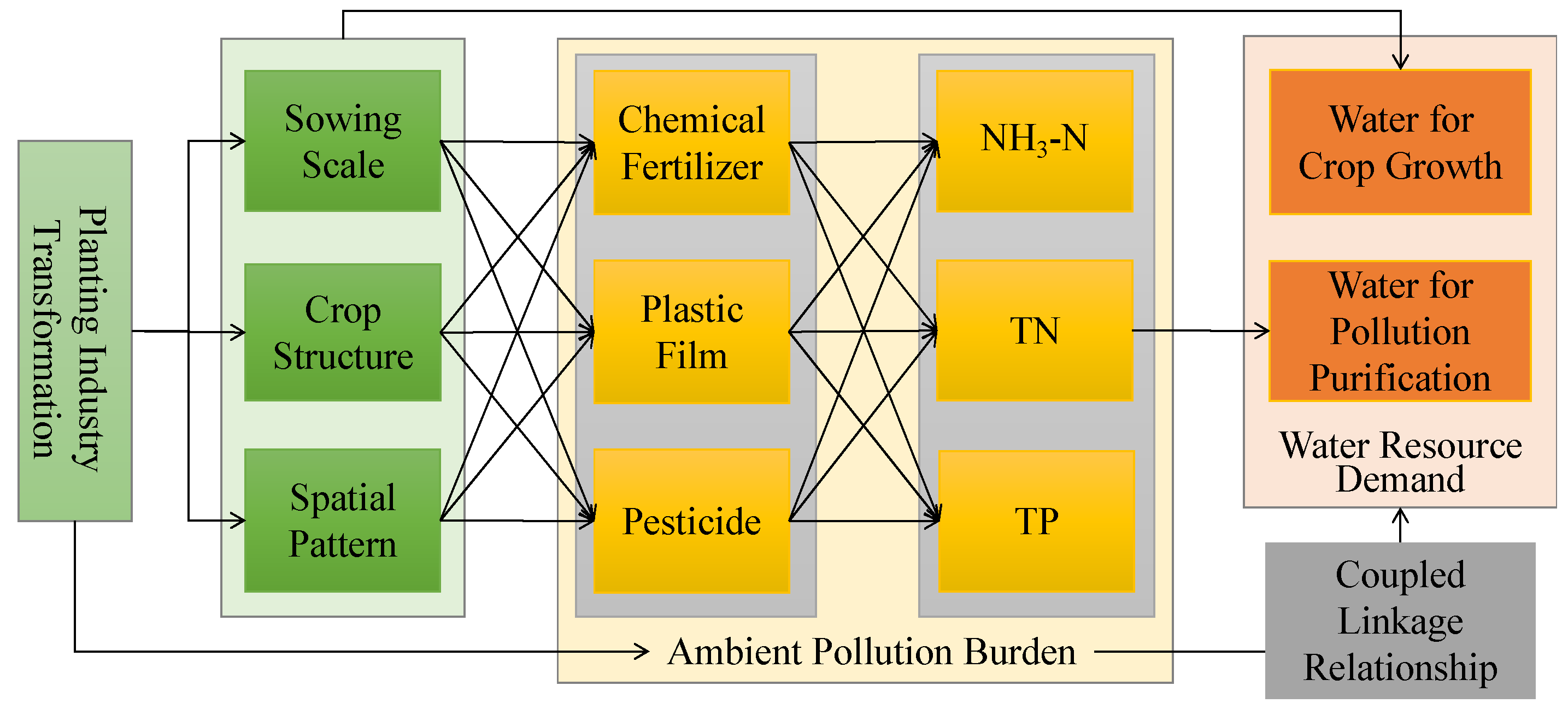
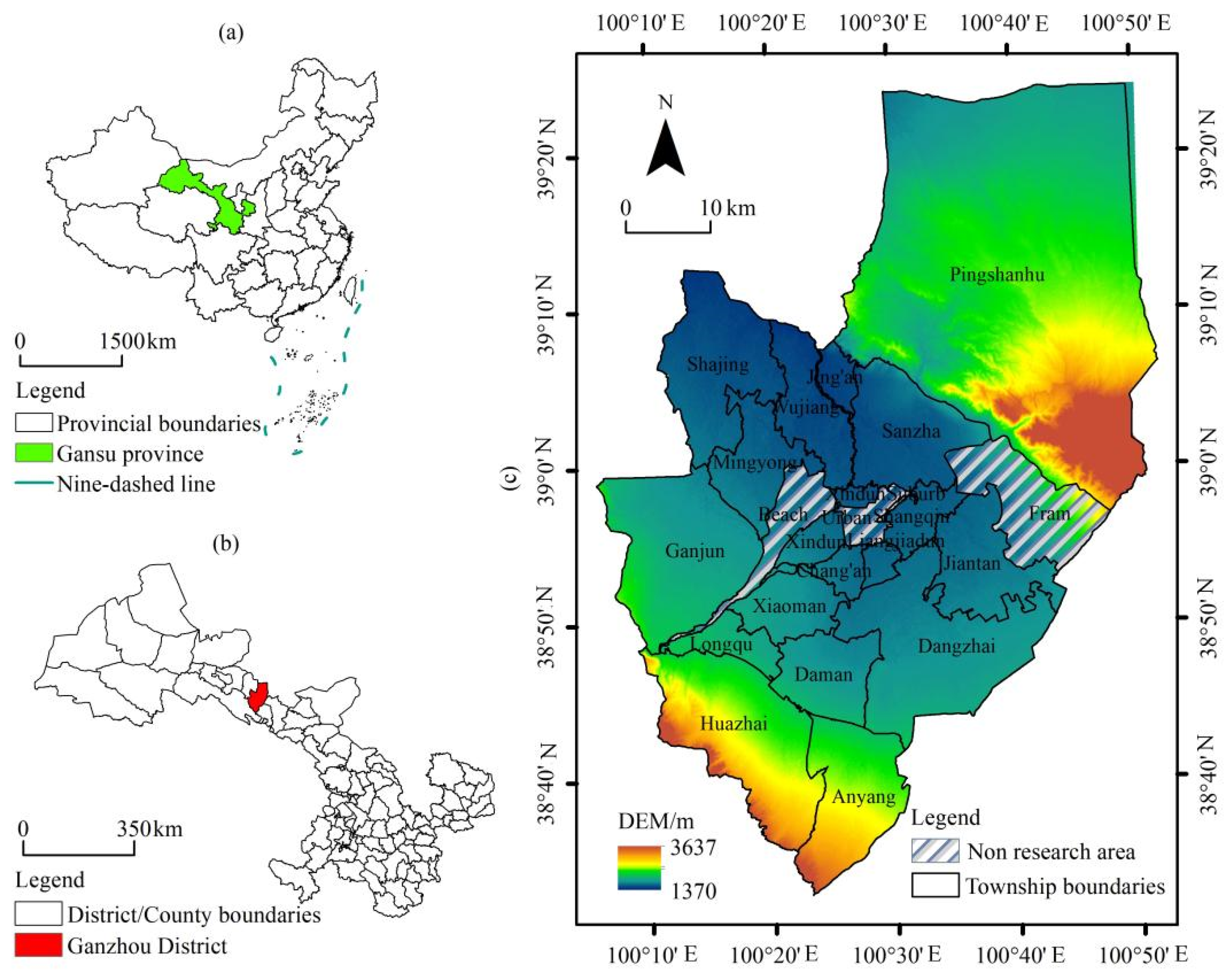
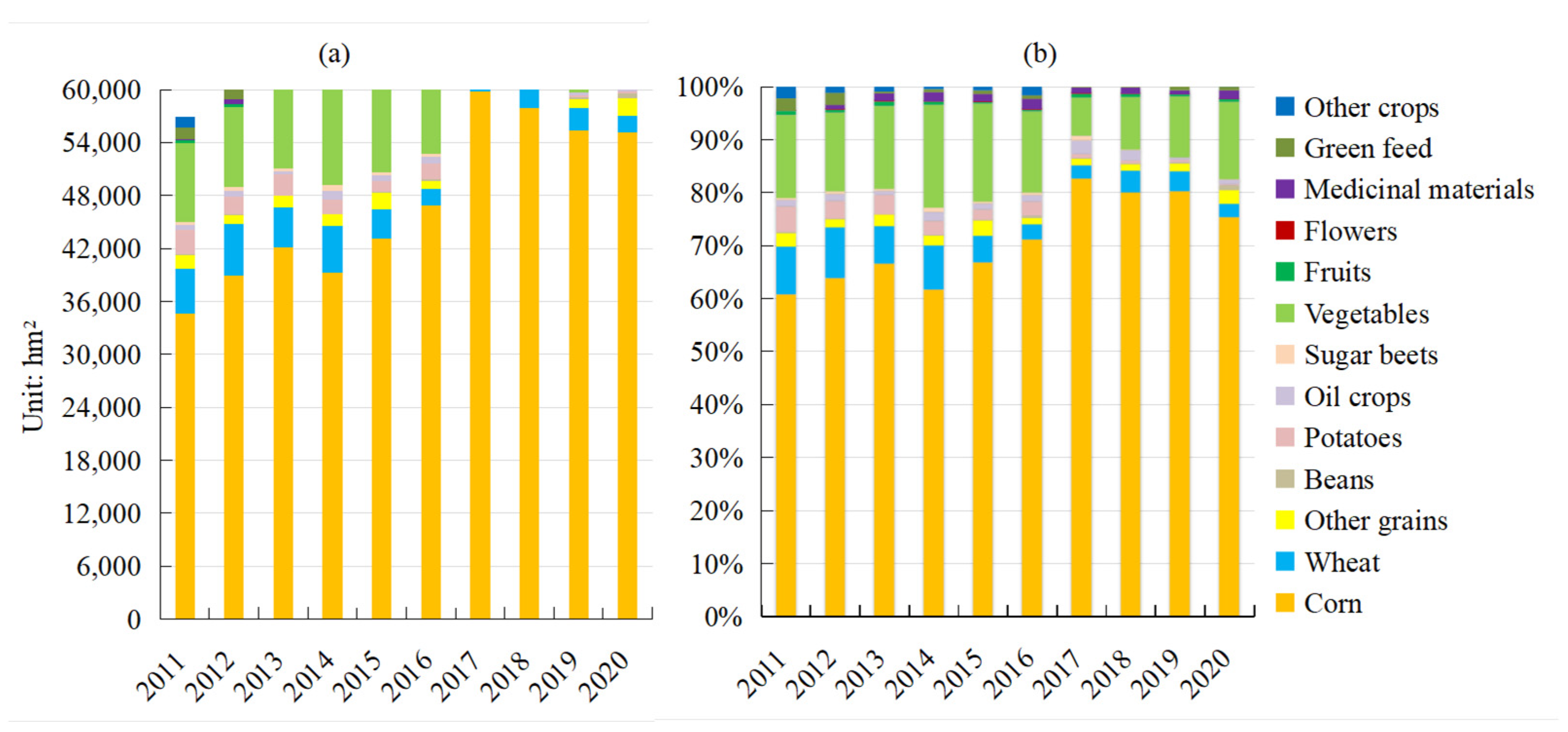
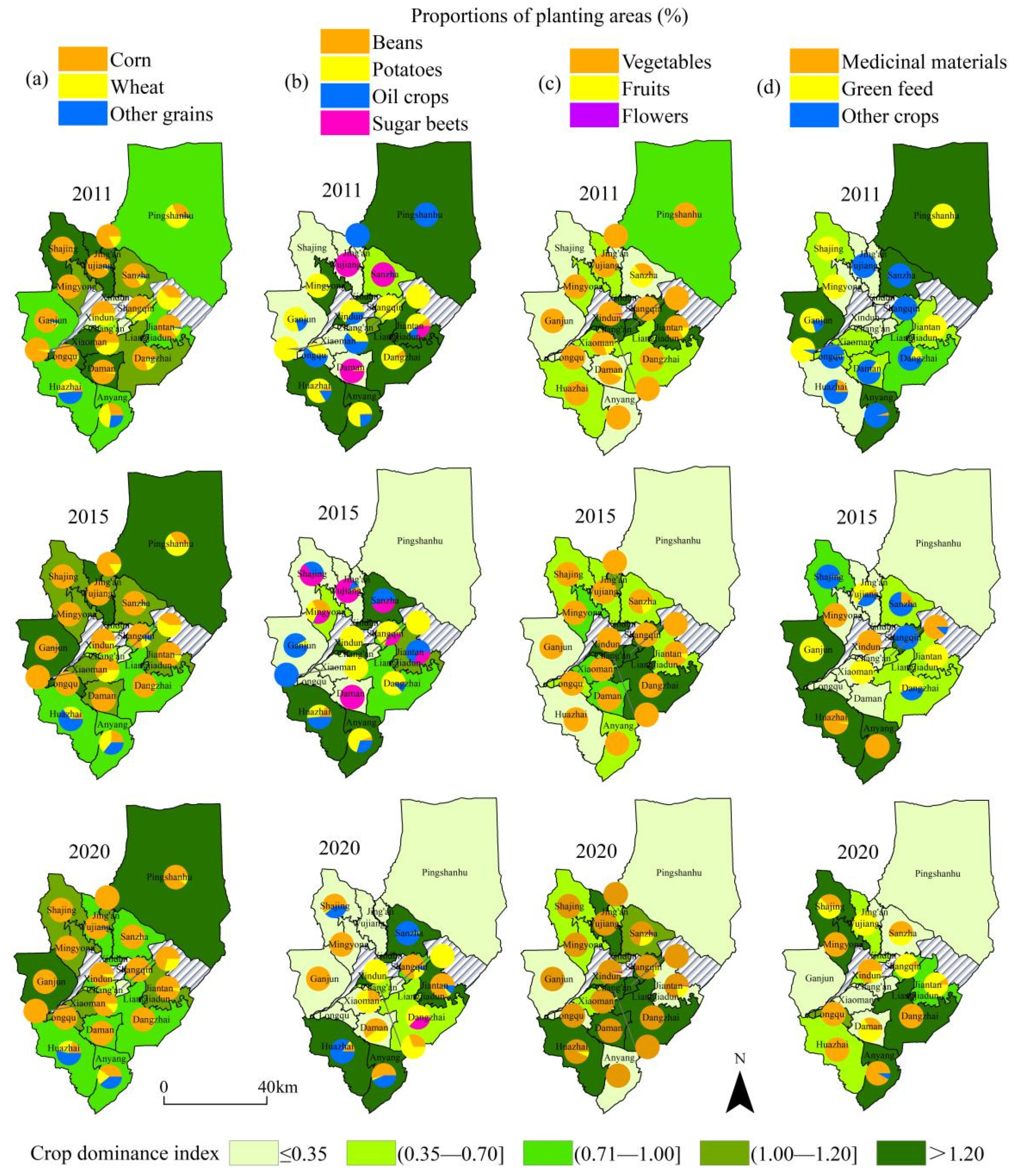
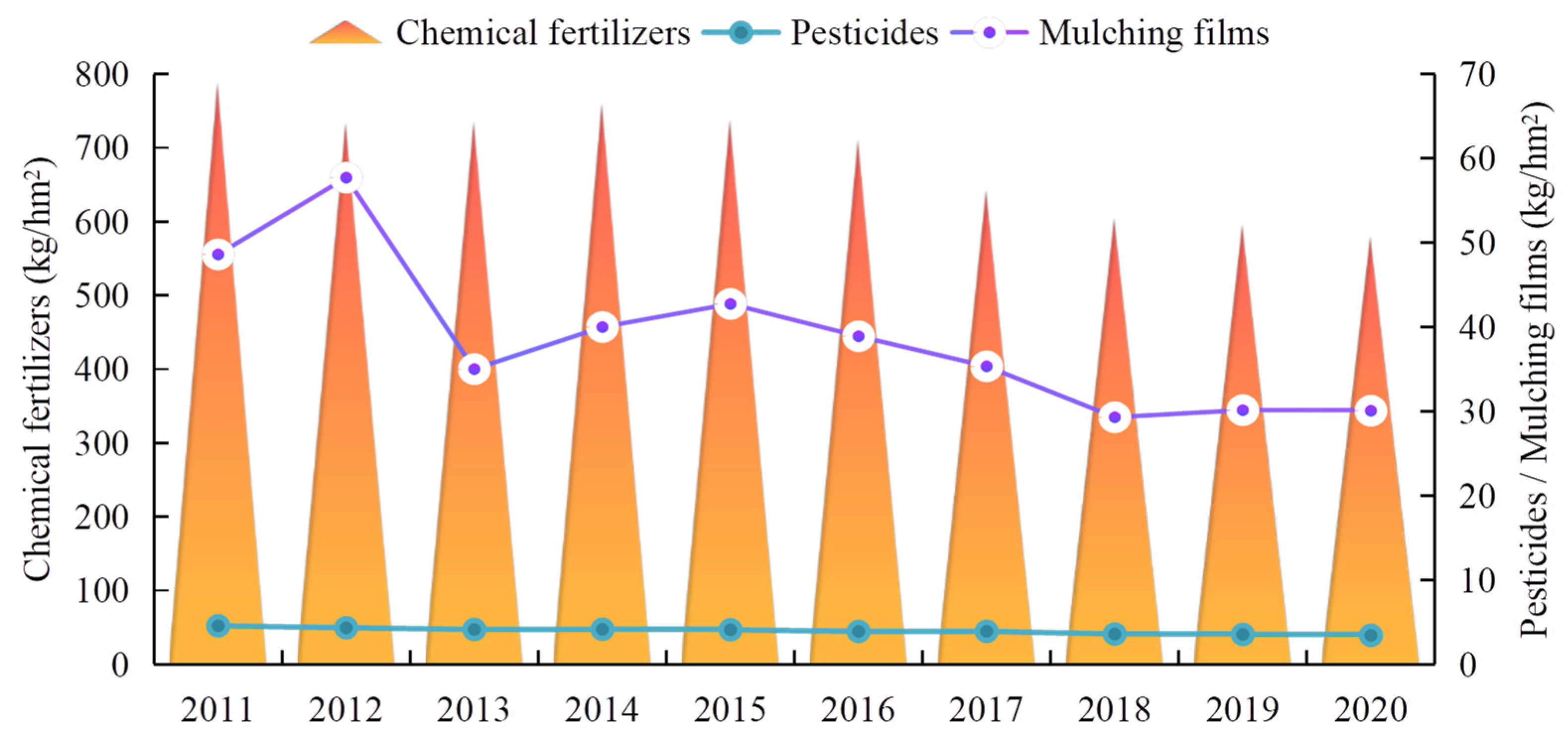
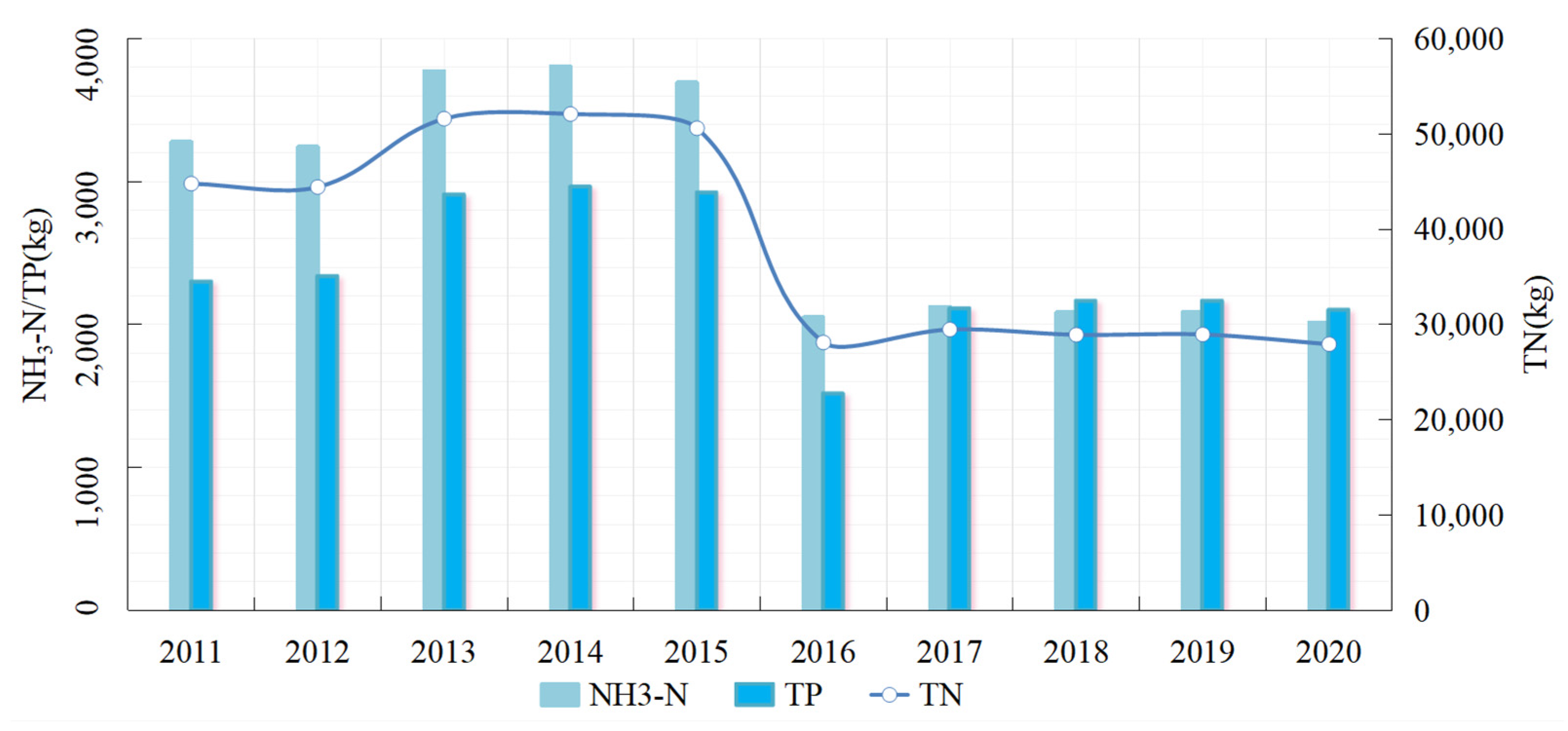
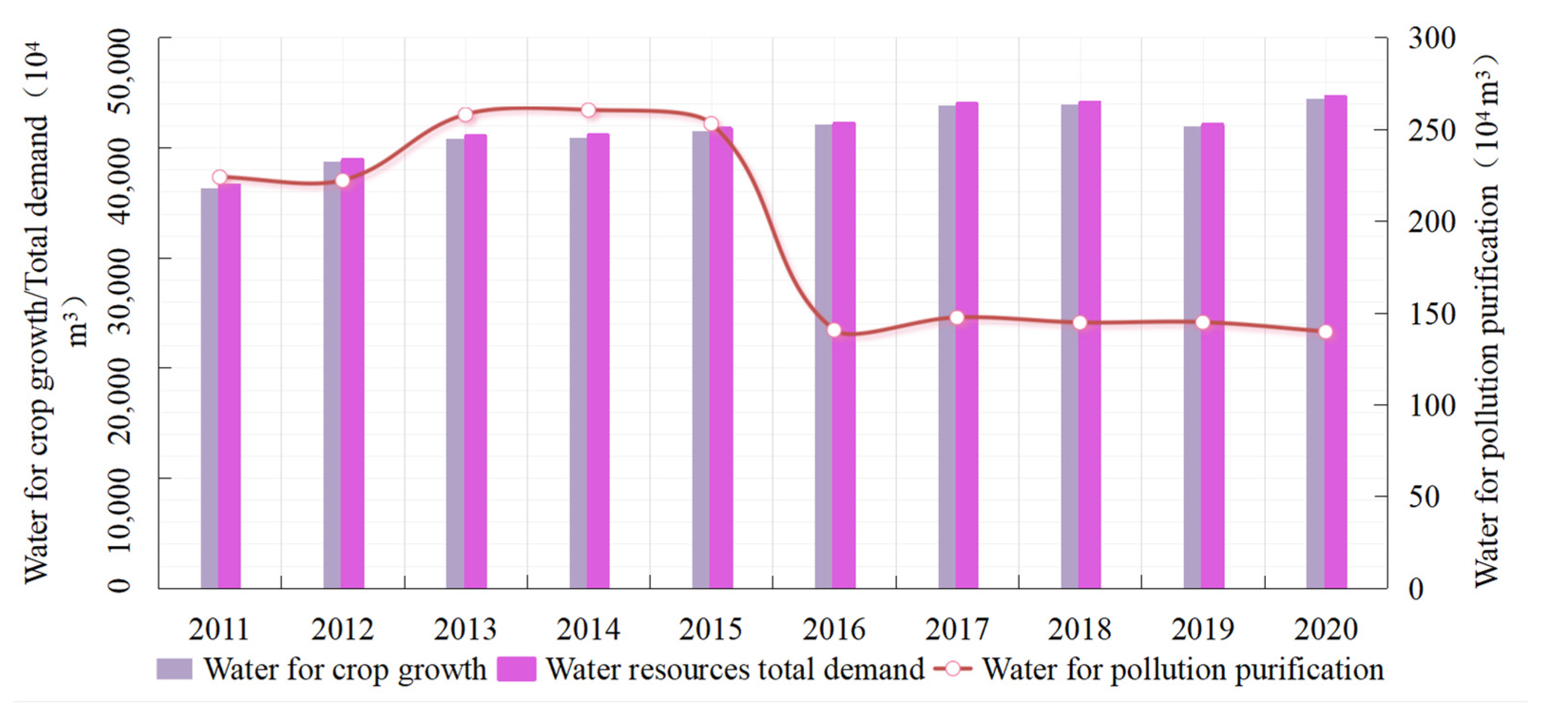
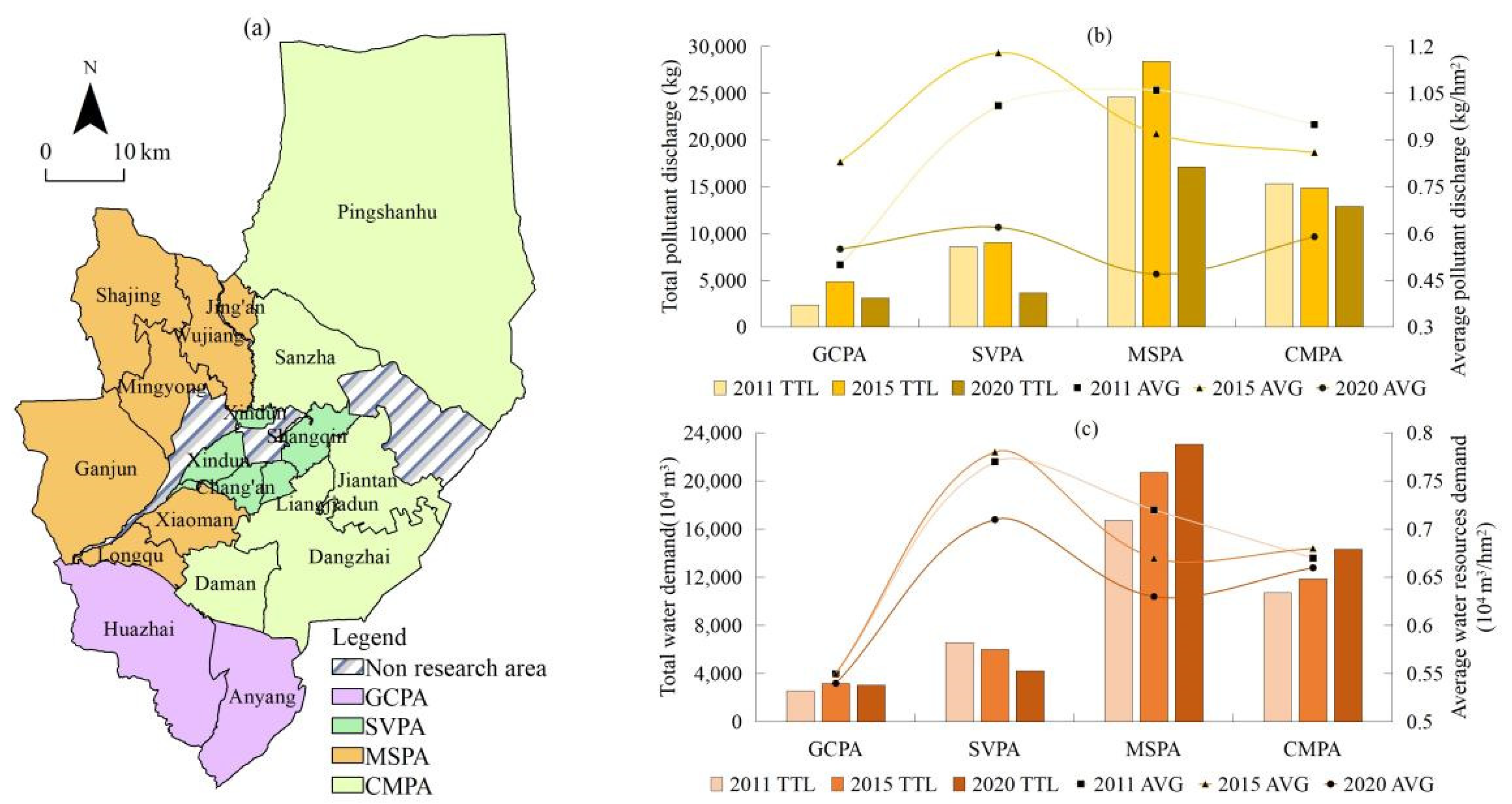
| Discharge Loss Coefficient of Crops during Sowing (kg/hm2) | Discharge Loss Coefficient in Garden Land (kg/hm2) | ||||
|---|---|---|---|---|---|
| Ammonia nitrogen | Total nitrogen | Total phosphorus | Ammonia nitrogen | Total nitrogen | Total phosphorus |
| 0.029 | 0.403 | 0.029 | 0.039 | 0.493 | 0.018 |
| Crop | Irrigation Norm (m3/hm2) | Crop | Irrigation Norm (m3/hm2) |
|---|---|---|---|
| Rice | 7500 | Sugar beet | 4725 |
| Wheat | 5250 | Vegetables | 6300 |
| Corn | 6150 | Flowers and Plants | 4800 |
| Other grains | 4800 | Fruits | 4800 |
| Beans | 5025 | Medicinal materials | 4725 |
| Potatoes | 3900 | Fruit-bearing forests | 3300 |
| Oilseed | 5025 |
| Resource and Environment Changes | Response Intensity | Response Relationship | Coupled Linkage Pattern between Planting Industry Transformation and Environmental Pollution Lode/Water Resource Demand |
|---|---|---|---|
| ∆RE > 0 | RS > 0 | Positive response | Synergetic evolutionary |
| RS < 0 | Negative response | Trade-off evolutionary | |
| ∆RE < 0 | RS > 0 | Positive response | Synergetic evolutionary |
| RS < 0 | Negative response | Trade-off evolutionary |
| Year | Planting Industry Transformation and Pollutant Discharge | Planting Industry Transformation and Water Resource Demand | ||||
|---|---|---|---|---|---|---|
| ∆Pollutant Discharge | RS Pollution Emission | Relationship | ∆Water Resource Demand | RS Water Resource Demand | Relationship | |
| 2011–2012 | −352.13 | −0.10 | trade-off | 2350.93 | 0.91 | Synergy |
| 2012–2013 | 8268.66 | 4.39 | Synergy | 2128.11 | 1.45 | Synergy |
| 2013–2014 | 584.02 | 1.49 | Synergy | 104.20 | 0.38 | Synergy |
| 2014–2015 | −1645.78 | −1.86 | trade-off | 596.90 | 0.96 | Synergy |
| 2015–2016 | −25,531.46 | −22.93 | trade-off | 474.24 | 0.58 | Synergy |
| 2016–2017 | 2029.26 | 0.65 | Synergy | 1775.57 | 0.43 | Synergy |
| 2017–2018 | −543.20 | 61.39 | Synergy | 99.70 | −8.63 | trade-off |
| 2018–2019 | 36.51 | −0.02 | trade-off | −1983.78 | 0.93 | Synergy |
| 2019–2020 | −1158.20 | −0.55 | trade-off | 2501.29 | 0.94 | Synergy |
| 2011–2020 | −18,312.33 | −1.27 | trade-off | 8047.16 | 0.77 | Synergy |
| Planting Pattern | Included Townships | Crop Planting Characteristics |
|---|---|---|
| GCPA | Huazhai and Anyang | Townships with wheat, other grains, beans, potatoes, oil crops, medicinal materials, and other crops as dominant crops. |
| SVPA | Chang’an, Liangjiadun, Shangqin, and Xindun | Vegetables were the dominant crops, and the proportion of the planting area remained above 40%. |
| MSPA | Shajing, Ganjun, Wujiang, Mingyong, Xiaoman, Longqu, and Jing’an | Corn was the dominant crop, and the proportion of the planting area used for growing seed corn remained above 70%. |
| CMPA | Pingshanhu, Sanzha, Jiantan, Dangzhai, and Daman | While the planting area for corn continued to expand, the townships had other food and cash crops as the dominant crops. |
Publisher’s Note: MDPI stays neutral with regard to jurisdictional claims in published maps and institutional affiliations. |
© 2022 by the authors. Licensee MDPI, Basel, Switzerland. This article is an open access article distributed under the terms and conditions of the Creative Commons Attribution (CC BY) license (https://creativecommons.org/licenses/by/4.0/).
Share and Cite
Huang, J.; Xue, D.; Wang, C.; Chen, J. Resource and Environmental Pressures on the Transformation of Planting Industry in Arid Oasis. Int. J. Environ. Res. Public Health 2022, 19, 5977. https://doi.org/10.3390/ijerph19105977
Huang J, Xue D, Wang C, Chen J. Resource and Environmental Pressures on the Transformation of Planting Industry in Arid Oasis. International Journal of Environmental Research and Public Health. 2022; 19(10):5977. https://doi.org/10.3390/ijerph19105977
Chicago/Turabian StyleHuang, Jing, Dongqian Xue, Chuansheng Wang, and Jiehu Chen. 2022. "Resource and Environmental Pressures on the Transformation of Planting Industry in Arid Oasis" International Journal of Environmental Research and Public Health 19, no. 10: 5977. https://doi.org/10.3390/ijerph19105977
APA StyleHuang, J., Xue, D., Wang, C., & Chen, J. (2022). Resource and Environmental Pressures on the Transformation of Planting Industry in Arid Oasis. International Journal of Environmental Research and Public Health, 19(10), 5977. https://doi.org/10.3390/ijerph19105977





